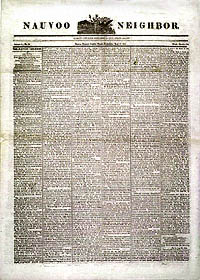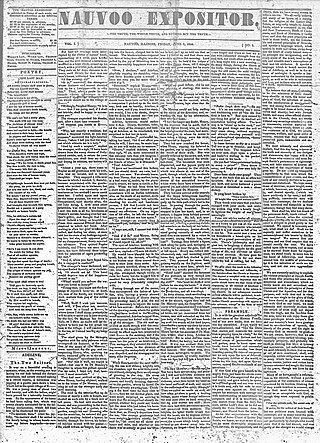
The Nauvoo Expositor was a newspaper in Nauvoo, Illinois, that published only one issue, on June 7, 1844. Its publication, the destruction of the printed copies, and the destruction of the printing press by the mob who followed the sheriff sent to collect the printed papers, set off a chain of events that led to Smith's death.

John Taylor was an English-born religious leader who served as the third president of the Church of Jesus Christ of Latter-day Saints from 1880 to 1887. He is the first and so far only president of the LDS Church to have been born outside the United States.
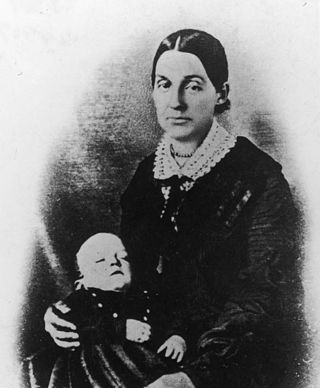
Emma Hale Smith Bidamon was an American homesteader, the first wife of Joseph Smith, and a prominent leader in the early days of the Latter Day Saint movement, both during Smith's lifetime and afterward as a member of the Reorganized Church of Jesus Christ of Latter Day Saints. In 1842, when the Ladies' Relief Society of Nauvoo was formed as a women's service organization, she was elected by its members as the organization's first president.

"The Council of Fifty" was a Latter Day Saint organization established by Joseph Smith in 1844 to symbolize and represent a future theocratic or theodemocratic "Kingdom of God" on the earth. Smith prophetically claimed that this Kingdom would be established in preparation for the Millennium and the Second Coming of Jesus.

Times and Seasons was a 19th-century Latter Day Saint newspaper published at Nauvoo, Illinois. It was printed monthly or twice-monthly from November 1839 to February 1846. The motto of the paper was "Truth will prevail," which was printed underneath the title heading. It was the successor to the Elders' Journal and was the last newspaper published by the Church in the United States before the schisms that occurred after the death of Joseph Smith.

George Quayle Cannon was an early member of the Quorum of the Twelve Apostles of the Church of Jesus Christ of Latter-day Saints, and served in the First Presidency under four successive presidents of the church: Brigham Young, John Taylor, Wilford Woodruff, and Lorenzo Snow. He was the church's chief political strategist, and was dubbed "the Mormon premier" and "the Mormon Richelieu" by the press. He was also a five-time Utah territorial delegate to the U.S. Congress.

Carthage Jail is a historic building in Carthage, Illinois, listed on the National Register of Historic Places (NRHP). It was built in 1839 and is best known as the location of the 1844 killing of Joseph Smith, founder of the Latter Day Saint movement, and his brother Hyrum, by a mob of approximately 150 men. It was added to the NRHP in 1973 and is operated by the Church of Jesus Christ of Latter-day Saints as a historic site with an adjacent visitors' center.
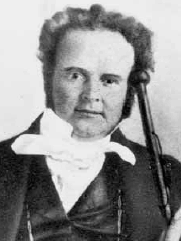
Willard Richards was a physician and midwife/nurse trainer and an early leader in the Latter Day Saint movement. He served as second counselor to church president Brigham Young in the First Presidency of the Church of Jesus Christ of Latter-day Saints from 1847 until his death.
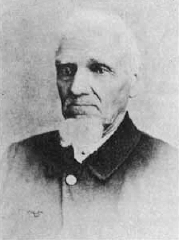
William Smith was a leader in the Latter Day Saint movement and one of the original members of the Quorum of the Twelve Apostles. Smith was the eighth child of Joseph Smith Sr. and Lucy Mack Smith and was a younger brother of Joseph Smith Jr., the founder of the Latter Day Saint movement.

The Kinderhook plates are a set of six small, bell-shaped pieces of brass with unusual engravings, created as a hoax in 1843, surreptitiously buried and then dug up at an Indian mound near Kinderhook, Illinois.

William Wines Phelps was an early leader of the Latter Day Saint movement. He printed the first edition of the Book of Commandments that became a standard work of the church and wrote numerous hymns, some of which are included in the current version of the Church of Jesus Christ of Latter-day Saints' hymnal. He was at times both close to and at odds with church leadership. He testified against Joseph Smith, providing evidence that helped persuade authorities to arrest Smith. He was excommunicated three times and rejoined the church each time. He was a ghostwriter for Smith. Phelps was called by Smith to serve as assistant president of the church in Missouri and as a member of the Council of Fifty. After Smith's death, Phelps supported Brigham Young, who was the church's new president.

William H. Clayton was a clerk, scribe, and friend to the religious leader Joseph Smith. Clayton, born in England, was also an American pioneer journalist, inventor, lyricist, and musician. He joined the Church of Jesus Christ of Latter Day Saints in 1837 and served as the second counselor to the British mission president Joseph Fielding while proselyting in Manchester. He led a group of British converts in emigrating to the United States in 1840 and eventually settled in Nauvoo, Illinois, where he befriended Joseph Smith and became his clerk and scribe. He was a member of the Council of Fifty and Smith's private prayer circle.

Orson Spencer was a prolific writer and prominent member of the Church of Jesus Christ of Latter-day Saints. He served in several highly visible positions within the church and left an extensive legacy of theological writings. Orson Spencer is one of the examples William Mulder cites of highly educated people becoming Mormons during the time of Joseph Smith
Neighbour, Neighbor, Neighbours or Neighbors may refer to:

The life of Joseph Smith from 1839 to 1844, when he was 34–38 years old, covers the period of Smith's life when he lived in Nauvoo, an eventful and highly controversial period of the Latter Day Saint movement. In 1844, after Smith was imprisoned in Carthage, Illinois, he was shot and killed when a mob stormed the jailhouse.
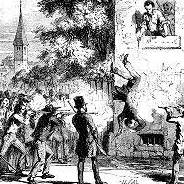
Joseph Smith, the founder and leader of the Latter Day Saint movement, and his brother, Hyrum Smith, were killed by a mob in Carthage, Illinois, United States, on June 27, 1844, while awaiting trial in the town jail.
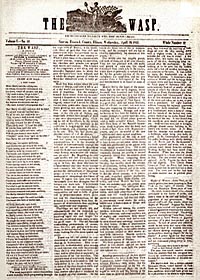
The Wasp was a weekly Latter Day Saint newspaper edited and published by William Smith in Nauvoo, Illinois, from April 1842 to April 1843. While it was not an official publication of the Church of Jesus Christ of Latter Day Saints, The Wasp was consistently pro-Mormon and its primary target audience was the Latter Day Saint residents of Nauvoo. The Wasp ceased publication when it was replaced by John Taylor's similarly themed Nauvoo Neighbor.

The Warsaw Signal was a newspaper edited and published in Warsaw, Illinois during the 1840s and early 1850s. For most of its history, the Signal's editorial stance was one of vigorous anti-Mormonism and the advancement of the policies of the Whig Party.
Ralph Partington was a Mormon pioneer.

Phrenology has been a cultural factor in the Latter Day Saint movement since around the time of its founding in 1830. Phrenology is a pseudoscience which involves the measurement of bumps on the skull to predict mental traits. Developed in the 1790s, it became widely popular in the United States in the 1830s and 1840s, coinciding with the rise of the Latter Day Saint movement.
